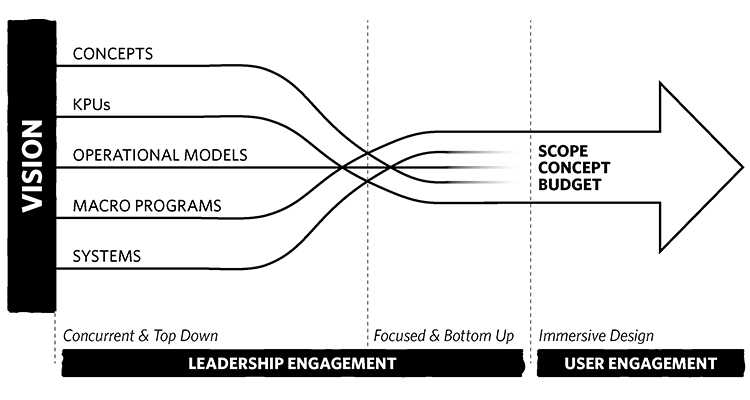
How We Align Vision, Scope and Budget for Healthcare Design
Design Smarter with Target Value Programming
At the foundation of every great hospital is a smart plan to deliver it on budget and on schedule without compromising design. One of the key methodologies we employ to achieve quality, contextually conscious healthcare design is Target Value Programming (TVP). This approach aligns project scope and budget from the outset, mitigating risk and enhancing design quality for projects of all scales. TVP sets programming and design in motion simultaneously, leading to better alignment between big design concepts and building program through intuitive budgets for specific components that are monitored in real time to avoid major course corrections.

Start Smart: Keeping Everything in Motion
In the first few months of a project, we bring together a focused core team — key stakeholders, clinical champions and our design leads — to define a clear scope and budget. This top-down, data-driven process sets the foundation for success.
We use real-time benchmarking and rapid design iteration to collaboratively:
- Define space needs and program size
- Explore big design ideas early
- Set intuitive budgets for each component
- Avoid costly course corrections later
This early alignment eliminates the need for value engineering and gives our designers the freedom to create spaces that reflect an organization’s identity and community needs.
An Inherently Flexible Process
Both The Ohio State University Wexner Medical Center New Hospital Tower and the UK HealthCare Albert B. Chandler Expansion have benefited from this design and programming strategy at different stages of its development. Within the first few months of these projects, a core team was developed to bring big design ideas, basic blocking and stacking concepts, and benchmarking data together to align budget, scope and vision on the same track. With this alignment, we were able to set aside a scope contingency to address new needs, adjust to program allotment, and flex and adapt the design and program to a strategic vision. Continuous validation and adjustment with key users and the core team have kept these projects on track and within budget through precision change management.

Forged within large-scale healthcare projects, TVP can be applied to smaller projects as well. For example, several mid-scale community hospital projects have employed this strategy to manage user expectations and stay within budget. By understanding the total budget and strategic vision from the start, we can create a realistic project scope to alleviate budgetary concerns while delivering remarkable design.
Constant Process Evolution
Early stages of a project often involve uncertainty about future demands and exact design requirements. We continuously validate and adjust with your team to respond to new demands, refine scope and keep costs in check. Our TVP approach has evolved through multiple projects to become a living process we actively evaluate during design, construction and after completion. At the heart of every exceptional hospital is a plan that works within budget, on schedule and with purpose.


